ISSN ONLINE(2319-8753)PRINT(2347-6710)
ISSN ONLINE(2319-8753)PRINT(2347-6710)
Mahalingegowda.H.B, B.S.Mahesh
|
| Related article at Pubmed, Scholar Google |
Visit for more related articles at International Journal of Innovative Research in Science, Engineering and Technology
Increase in the performance requirements of materials for aerospace and automobile applications has led to the development of numerous structural composite materials. Some of these composites are particle-reinforced metals-matrix composites, ceramic particle reinforced composites. These composites by virtue of their higher specific strength and stiffness, improved elevated performance, have become important and necessary materials used in various industrial applications. Therefore the mechanical properties of these composites have received much attention. Some of the techniques used for the development of these composites are stir casting, powder metallurgy and squeeze-casting. In this paper we made an attempt to study the mechanical and wear behaviour of Al alloy composites containing various al2o3 compositions namely 3%, 6% and 9% by weight, were fabricated and tested, and their properties were compared with Al alloy hybrid composites containing 2 wt% Graphite constant and various al2o3 compositions namely 3%, 6% and 9% by weight.
Keywords |
| 6061AlAlloy, Al2O3and Graphite Particulates, Tensile Strength, Hardness, Hybrid Metal Matrix Composites, Stir-Casting, Wear. |
INTRODUCTION |
| A composite material is a ‘material system’ composed of a combination of two or more micro or macro constituents that differ in form, chemical composition and which are essentially insoluble in each other. One constituent is called as Matrix Phase and the other is called reinforcing phase. Reinforcing phase is embedded in the matrix to give the desired characteristic. Metal matrix composites (MMCs) are increasingly becoming attractive materials for advanced aerospace, automobiles, turbines, etc applications but their properties can be tailored through the addition of selected reinforcement. |
| In particular particulate reinforced MMCs have recently found special interest because of their specific strength and specific stiffness at room or elevated temperatures. It is well known that the elastic properties of the metal matrix composite are strongly influenced by micro-structural parameters of the reinforcement such as shape, size, orientation, distribution and volume or weight fraction [1][2] |
| Das et al [3] have demonstrated dry sliding wear behaviour, aluminum alloy reinforced with reinforced with SiCp- Graphite. The un-lubricated pins on disc wear test were conducted, to examine the wear behaviour of aluminum alloy and its composites. They reported that wear rate of graphite composites is lower than that of matrix alloy and SiCp reinforced composite. |
| Sharma et al [4] have studied liquid metallurgical technique. A pin on disc wear testing machine was used to carry out the tribological tests on both composites and matrix alloy over a load range of 10–50N and sliding velocities of 1.25– 3.05 m/s for various sliding distances of 0.5–3 km.The wear resistances of Al6061 matrix, garnet particulate reinforced composites are superior to that of unreinforced matrix alloy. Hosking et al [10] reported an increase in the dry sliding wear resistance of 2014Al- Al2O3 with increasing weight percent and size of non-metallic particles. |
| Wang et al [5] conducted wear test on pin-on-disk wear test for MMCs and reported that different orientation of reinforcement gives the better result. The friction performance of Al 10% SiCp MMCs against steel was studied for varying tribological test parameters. Applied load is the most important factor which is influencing the friction performance. |
| The Wear Behaviour Of The Sliding Components Is Of Ut- Most Importance Avoiding Huge Economic Losses. Tri- Bological Characteristics Of Several Mmc Systems In- Volving Glass, Flash, Sic, Graphite, Mica, Al2O3 As Dis- Continuous Dispersoids Have Been Reported [6-7]. |
| Micro structural characterization was investigated by optical (OP). The aluminium alloy hard particle composite can successfully be synthesized by solidification process (stir casting or vortex technique).Aluminium composite so developed exhibit uniform distribution of the particle in the matrix and good interface bonding between the ceramic phase and the metallic matrix. The investigation reveals the. Both the composites fabricated with liquid metallurgy route. The structure and the properties of these composites are controlled by the type and size of the reinforcement and also the nature of bonding [8]. |
EXPERIMENTAL RESULTS |
Materials |
Aluminium 6061 |
| It is commonly available in pre-tempered grades such as 6061-O (solutionized) and tempered grades such as 6061-T6 (solutionized and artificially aged) and 6061-T651 (solutionized, stress-relieved stretched and artificially aged). 6061 is a precipitation hardeningaluminum alloy, containing magnesium and silicon assists major alloying elements. It has good mechanical properties and exhibits good weldability. It is one of the most common alloys of aluminum for general purpose use. 6061 has a density of 2.70 g/cm³. |
| Table 1: Chemical Composition of Al6061 Alloy by Weight Percentage |
Aluminium oxide Al2O3 |
| Aluminium oxide is a chemical compound of aluminium and oxygen with the chemical formula Al2O3. It is the most commonly occurring of several aluminium oxides, and specifically identified as aluminium (III) oxide. It is commonly called alumina, and may also be called aloxide, aloxite, or alundum depending on particular forms or applications. |
Graphite |
| The mineral graphite (pronounced graefart) is one of the allotropes of carbon. It was named by Abraham Gottlob Werner in 1789 from the Ancient Greek "to draw/write", for its use in pencils, where it is commonly called lead (not to be confused with the metallic element lead). Unlike diamond (another carbon allotrope), graphite is an electrical conductor, a semimetal. It is, consequently, useful in such applications as arc lampelectrodes. Graphite is the most stable form of carbon under standard conditions. Therefore, it is used in thermo chemistry as the standard state for defining the heat of formation of carbon compounds. |
| In the present work, Al6061-Al2O3 composites and Al6061-Al2O3-Gr hybrid composites are successfully fabricated by using liquid metallurgy route. The percentage of Al2O3 varied from 3-9 wt%, and also 2 wt% Gr constant for hybrid composites. The cast composites and hybrid composites are subjected to mechanical studies such as Microstructure studies, Hardness, Tensile strength and Compressive strength. |
Procedure for casting of Al6061-Al2O3 metal matrix composites And Al6061-Al2O3-Gr hybrid composite: |
| The method adopted for preparation of composite was liquid metallurgy route. Al6061 is used as the base material and Al2O3 and Gr in powder form was chosen as the reinforcement materials. The matrix Al6061 was heated and melted in a resistance furnace with coil heating element. The maximum temperature limit is 10000C. Degassing is achieved by hexaclhoroethane tablet which were immersed into molten metal before stirring [1] [2]. |
| In order to get uniform distribution of Al2O3 and Gr particles, the composites was stirred continuously for duration of 10 minutes. The composites melt was then poured into preheated metal mould. Al6061-Al2O3 composites and Al6061- Al2O3-Gr hybrid composites with reinforcement of 3%, 6%, 9% have been successfully casted. |
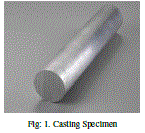 |
Testing of composite: |
Tensile Test: |
| A Tensile test also known as tension test is probably the most fundamental type of mechanical test that can perform on material |
| The ability to predict the loads that will cause a part to fail depends upon both material properties and the machine part geometry. This lab involves two testing procedures that are used to verify these characteristics. The first test is a materials test known as a tensile test which is used to determine/verify material properties. The second test is a failure test which is used to determine/verify the loading level that will cause a machine part to fail. |
| Table 3: Tensile strength values of composites |
 |
| Table 4: Tensile strength values of hybrid composites |
 |
| Shows the Tensile strength for Al6061-Al2O3-Gr hybrid composites. It is observed from the graph that there is an increase in Tensile strength by adding Al2O3 to Al6061. But adding of Gr decreases the Tensile strength. The Tensile strength for various proportion of Al2O3 i.e., for 3% Al2O3, 6% Al2O3&9% Al2O3 is as shown in figure |
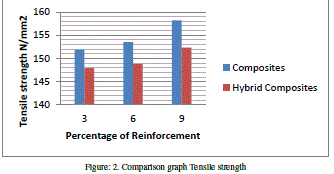 |
4. Compressive strength: |
| The compressive strength of Al6061-Al2O3 composites and Al6061-Al2O3-Gr hybrid composites are shown in tables (5) and Table(6). |
| Table: 5 |
 |
| Table: 6 |
 |
| Table Shows the Compressive strength for Al6061-Al2O3-Gr hybrid composites. It is observed from the graph that there is an increase in Compressive strength by adding Al2O3 to Al6061. But adding of Gr increases the Compressive strength. The Compressive strength for various proportion of Al2O3 i.e., for 3% Al2O3, 6% Al2O3&9% Al2O3 is as shown in figure(3). |
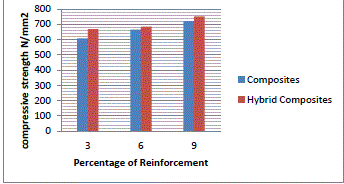 |
| Figure: 3. Comparison graph compressive strength |
Microstructure: |
| The optical microphotographs of the cast Al6061-Al2O3 composites and Al6061-Al2O3-Gr hybrid composites are shown in below figures. |
Al6061-3% of Al2O3 |
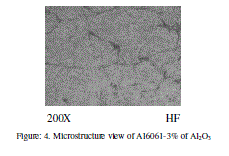 |
| Result: Microstructure consists of fine precipitates of Al-Si-Mg in a matrix of aluminium solid solution. Grain Refinement has been observed. |
2. Al6061-6% of Al2O3 |
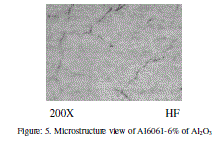 |
| Result: Microstructure consists of fine precipitates of Al-Si-Mg in a matrix of aluminium solid solution. Grain Refinement has been observed. |
3. Al6061-9% of Al2O3 |
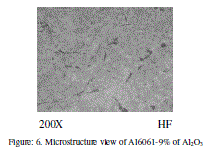 |
| Result: Microstructure consists of fine precipitates of Al-Si-Mg in a matrix of aluminium solid solution. Grain Refinement has been observed. |
4. Al6061-3% of Al2O3-2% of Gr |
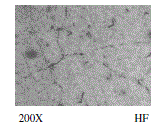 |
| Figure: 7. Microstructure view of Al6061-3% of Al2O3-2% of Gr |
| Result: Microstructure consists of fine precipitates of Al-Si-Mg in a matrix of aluminium solid solution. Grain Refinement has been observed. |
5. Al6061-6% of Al2O3-2% of Gr |
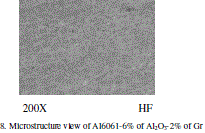 |
| Result: Microstructure consists of fine precipitates of Al-Si-Mg in a matrix of aluminium solid solution. Grain Refinement has been observed. |
6. Al6061-9% of Al2O3-2% of Gr |
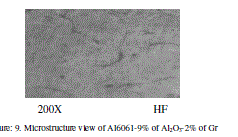 |
| Result: Microstructure consists of fine precipitates of Al-Si-Mg in a matrix of aluminium solid solution. Grain Refinement has been observed. |
| Hardness: |
| The hardness of Al6061-Al2O3 composites and Al6061-Al2O3-Gr hybrid composites are shown in table (7)and(8). Table: 7 |
 |
| Table: 8 |
 |
| Figure shows the comparison graph of Al6061-Al2O3 composites and Al6061-Al2O3-Gr hybrid composites. It is observed from the graph that adding of Al2O3 to Al6061increases the hardness but adding of Gr to Al6061 decreases the hardness. |
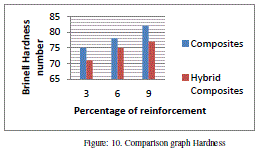 |
WEAR |
| Wear is a process of removal of material from one or both of two solid surfaces in solid state contact, occurring when two solid surfaces are in sliding or rolling motion together. |
DRY SLIDING WEAR STUDY |
| The wear tests are conducted by using pin-on Disc wear testing machine. The wear rate of specimen was found by weight loss method. The sliding distance was found by dividing the weight lost for known distance. Wear testing was carried out at a different sliding velocity with different normal loads. A cylindrical pin of size 8 mm diameter and 30mm length, prepared from composite casting, was loaded through a vertical specimen holder against horizontal rotating disc. The rotating disc was made of carbon steel of diameter 1200 mm and hardness of 60 HRC. The weights were measured before and after each test segment to determine the abrasive wear loss of each sample. |
| Table: 9Technical specifications of pin-on disc wear testing machine |
 |
 |
| In this test we made an attempt of finding the wear rate by keeping load and sliding distance constant [i.e. load =20N ,sliding distance =2000m] then the result values of wear rate in microns get compared between the various compositions of composite and hybrid composites. That can be plotted by bar chart |
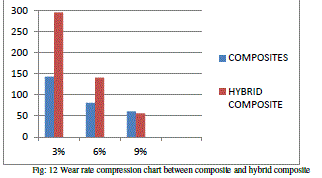 |
| As an increase of Al2O3 leads good wear resistance and with assist of Gr it gives very good lesser wear rate |
CONCLUSION |
| 1. The microphotographs indicate the evidence of minimal porosity in base alloy, composites and the hybrid composites. It was observed from the microstructure test that reinforcement materials have distributed homogeneously. |
| 2. The hardness of AL6061- Al2O3composites increases by adding Al2O3 to Al6061. |
| 3. The hardness of Al6061- Al2O3 -Gr hybrid composites increases by adding Al2O3 and decreases by adding Al2O3 and decreases by adding Gr to Al6061. But compared to composites it is low. |
| 4. Tensile strength of AL6061- Al2O3 composites is high compared to AL6061- Al2O3-GR hybrid composites. |
| 5. The compressive strength of AL6062- Al2O3 composites increase by adding Al2O3 to AL6061. |
| 6. THE compressive strength of al6061- Al2O3-gr hybrid composites increase by addingAl2O3 and GR to AL6061. But compared to composites it is high. |
| 7. The aluminium alloy metal matrix material with mixing of reinforcement of alumina and graphite is to improve the wear behaviour |
References |
|